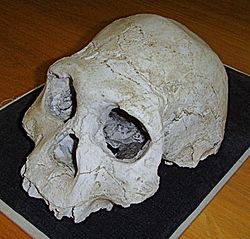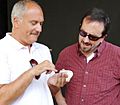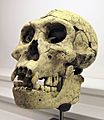Homo georgicus facts for kids
Quick facts for kids Homo georgicusTemporal range: Pleistocene
|
|
|---|---|
 |
|
| Skull D2700 (Replica) | |
| Scientific classification | |
| Kingdom: | |
| Phylum: | |
| Class: | |
| Order: | |
| Family: | |
| Genus: | |
| Species: |
H. georgicus
|
| Binomial name | |
| †Homo georgicus Vekua et al., 2002
|
|
Homo georgicus is an ancient human species. Scientists suggested this name in 2002. Its fossils, including skulls and jaws, were found in Dmanisi, Georgia. These fossils seem to be a link between Homo habilis and Homo erectus.
A partial skeleton was also found in 2001. These amazing fossils are about 1.8 million years old! The first remains were discovered in 1991 by Georgian scientist David Lordkipanidze. An international team helped him find more bones. Simple tools and animal bones were found near these ancient human remains.
At first, scientists thought these bones belonged to Homo ergaster. But the size differences made them decide to name a new species.
Discovering Homo georgicus
Where were the fossils found?
The fossils of Homo georgicus were found in a place called Dmanisi. This site is in the country of Georgia. It's a very important place for studying early humans.
Who found the fossils?
The first discovery was made in 1991 by a Georgian scientist named David Lordkipanidze. Later, in 1999 and 2001, his team found more skulls and jaws. They also found a partial skeleton in 2001.
How old are these fossils?
These fossils are very old! They are about 1.8 million years old. This makes them some of the earliest human fossils found outside of Africa.
What was found with the bones?
Along with the human bones, scientists found stone tools. They also found bones from animals. This tells us about the environment these early humans lived in. It also shows us what they might have eaten or hunted.
Understanding Homo georgicus
Scientists often discuss how Homo georgicus fits into the human family tree. Some experts think it's a separate species. Others believe it might be a type of Homo erectus, perhaps a subspecies called Homo erectus georgicus.
What makes H. georgicus special?
The fossils from Dmanisi show some interesting features. Their brain size is smaller than what was usually expected for Homo erectus. This discovery has made scientists rethink how they classify early human species.
For example, if H. georgicus and Homo floresiensis (another small early human) are part of Homo erectus, then the brain sizes for Homo erectus would vary a lot. This shows how complex the study of human evolution can be!
Why is classification still debated?
The way we classify these ancient human species is still being discussed. Scientists look at many things, like brain size, body size, and bone shapes. Homo georgicus was smaller than the classic Homo erectus, which was as tall as modern humans. These differences lead to ongoing debates among scientists.
Images for kids
-
Georgian archaeologist and anthropologist David Lordkipanidze (left) showing a hominin jaw discovered at Dmanisi to American ambassador John R. Bass in 2010
-
Replicas of the D211 (right, discovered in 1991) and D2735 (left, discovered in 2001) mandibles
-
Dmanisi Skull 3 compared to skulls of H. naledi, H. habilis and H. floresiensis.
-
Comparison of the mandibles of various species of Homo; D2600 (belonging to Skull 5) and D211 (belonging to Skull 2) are featured
-
The Dmanisi hominins may have partly fed on hackberries (pictured), since hackberry seeds have been found in conjunction with the hominin fossils.
See also
 In Spanish: Homo georgicus para niños
In Spanish: Homo georgicus para niños














